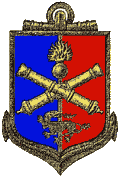School of Applied Artillery

The School of Applied Artillery (French: École d'application de l'artillerie) is an applied military academy of the French Army.
Pre-Revolutionary history
During the 18th Century, there were several artillery schools. The first was created by Louis XIV in Douai in 1679. Later schools were created in Metz and Strasbourg. In 1671 the king created a Royal Fusilier Regiment responsible for artillery, composed of four companies: gunners, sappers and entrenchers, carpenters, and other artillery laborers who were used as bridge-builders.[1] Other artillery schools were founded in Besançon, Grenoble, Auxonne, Metz, Perpignan and Valence.
- Thus, according to Mau of Jaisse, there were five schools by 1680.
- According to the General Map of the French Monarchy of 1720, they were then located in Metz, Fère, Strasbourg, Perpignan and Grenoble.
- According to the Royal Almanac, in 1789 there were seven artillery schools, in Valence, Douai, Auxonne, Fère, Metz, Besançon and Strasbourg.[2]
In 1693, the Royal Fusilier Regiment took the name "Royal Artillery", and in 1755 they were joined with companies of sapper s and engineers to create the Royal Corps of Engineers and Artillery. In 1758 the corps of engineers and the artillery were separated.
After the French Revolution
By the Decree of 18 Floréal of the Year III (by the French Republican Calendar), a new artillery school was created in Toulouse, bringing the total number to eight. An advanced (élèves) artillery school was founded in 1791 in Châlons-en-Champagne (Châlons-sur-Marne). In 1807 it joined with the School of Engineering to form the School of Applied Artillery and Engineering in Metz. This school was relocated to Fontainebleau in 1871. The School of Artillery became independent in 1912. Then artillery units moved to Nîmes (1940–1942), and then relocated to the United States military base in Cherchell, Algeria (1942–1945) for during the Second World War.
After World War II
After the liberation of France in 1945, the school was re-formed in Idar-Oberstein. At the same time, the Center for Ground Anti-Aircraft Forces was created in Nîmes, before becoming the School of Applied Ground-to-Air Artillery (EAASA). At the end of 1952, the School of Applied Artillery was reinstated in its town of origin: Châlons-sur-Marne
In 1976, the school moved to new buildings near Draguignan before joining the EAASA in 1983. In 1995, Arnaud Beltrame, who would sacrifice his life to safe a hostage in a terrorist attack in 2018, graduated from the School of Applied Artillery.
References
- ↑ Dictionnaire historique des institutions, moeurs et coutumes de la France par Adolphe Chéruel
- ↑ Histoire de l'instruction publique en Europe et principlamenet en France par Auguste Vallet de Viriville
External links
- Official site of the Ecole d'application de l'artillerie on the Ministry of Defense website.(in French)